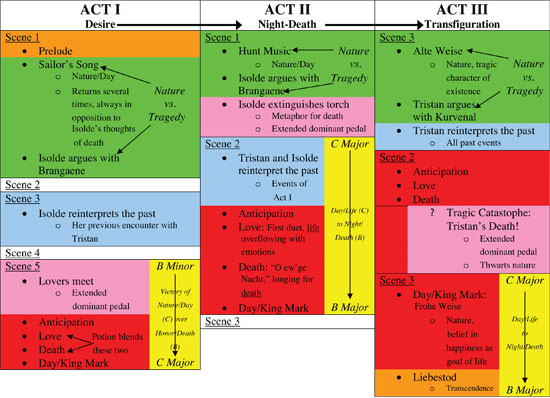







This table helps to show some parallelisms between the three acts of Tristan and Isolde. The information in the table is based on Chafe’s chapter seven: “Tragedy and Dramatic Structure.” The prelude and the Liebestod are both in orange because they work together to frame the opera. They also appear alone together in the concert version: as a frame with no opera in the middle.
At the beginning of each act, there is some sort of “natural” music that eventually becomes replaced by a tragic situation or discussion (shown in green). Chafe says that “In Schopenhauer’s view, of all the poetic forms only tragedy could turn the will away from nature.” This opposition of tragedy and nature is made clear by the placement of the music. The sailor’s song, the hunting music, and the shepherd’s sad alte Weise are all followed by scenes “in which one of the lovers opposes the conventional views of a secondary character (Isolde and Brangaene in acts 1 and 2, Tristan and Kurvenal in act 3)” (Chafe, 131).
Chafe adds to this by quoting Schopenhauer himself: “At the moment of the tragic catastrophe, we become convinced more clearly than ever that life is a bad dream from which we have to awake.” This awakening happens at the tragic catastrophe in Tristan und Isolde: Tristan’s death (in pink). At that moment, the will turns away from nature, and is sharply contrasted with nature, as well. Immediately following Tristan’s death, the listener hears the frohe Weise, perhaps the most natural music in the entire opera. It is important to note that Isolde’s extinguishing the torch (Act II, scene 1, in pink) is a symbolic act. It is a metaphor for death, and that death is realized in Act III, scene 2, when Tristan dies (also in pink). The pink in Act I connects the first time the lovers meet with these other two scenes by the use of an extended dominant pedal (a device which is always associated with the lovers meeting).
Each of the blue areas in the chart shows an instance where one of the lovers reinterprets the past “as an essential part of the process through which understanding moves forward. The reinterpretations become progressively more internal and dreamlike from act to act” (Chafe 131-2).
The red sections correspond with the three love scenes of Tristan and Isolde: Act I scene 5, Act II scene 2, and Act III scenes 2-3. Each love scene is structured in the same way. A period of anticipation is followed by the love scene itself. Next there is always an action related to death, and then the scene is ended with King Mark (who represents life and day) counteracting the death-related part. The key progressions (in yellow) that accompany the love scenes (in red) determine the outcome of each of these scenes. In the Act I love scene, the music progresses from B (night/death) to C (day/life). The direction of the key change switches in Acts II and III: B (night/death) gains victory over C (day/life) because between Acts I and II, Tristan and Isolde’s viewpoint of death changes very significantly.
